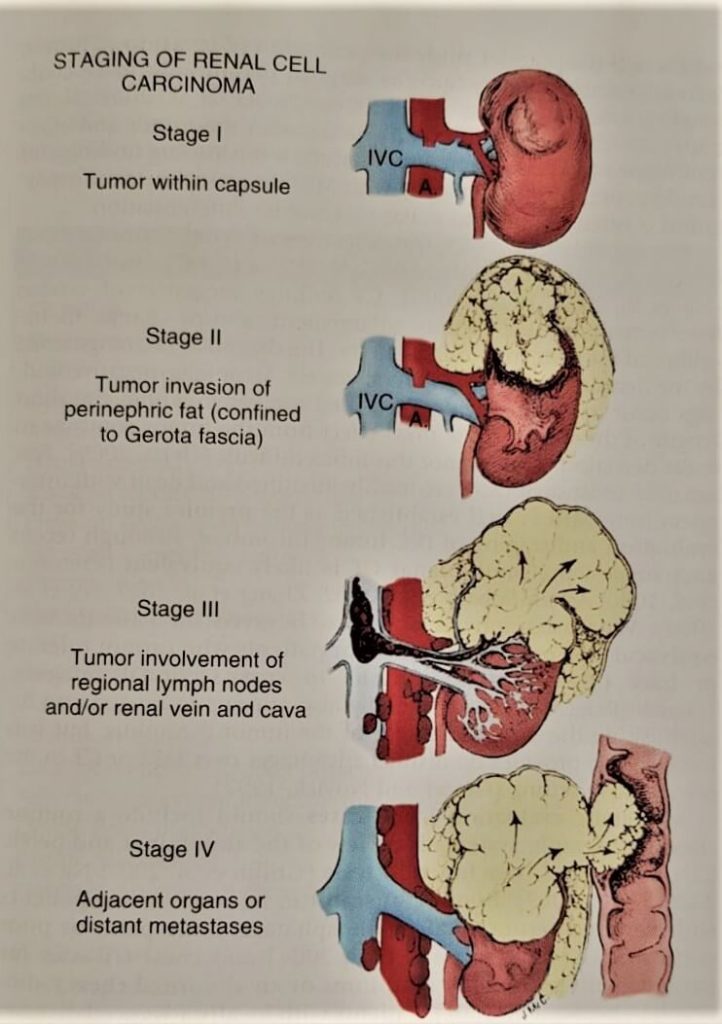Kidney Cancer Treatment in Navi Mumbai by Kidney Cancer Specialist Doctor - Dr Soumyan Dey
Kidney Cancer is one of the most cancers of the urinary tract in men
Please share your kidney cancer related query so we can help you better
A very large Kidney Cancer Successfully operated by Dr. Soumyan Dey.

Kidney Cancer Treatment Process
Whenever someone comes to Dr. Dey for the treatment of Kidney Cancer. Dr. Dey who is best kidney cancer surgeon in Navi Mumbai follows a evidence based approach to identify the best course of treatment.
Today there is extensive evidence from around the world on how to treat kidney cancers which Dr. Dey keeps abreast with and applied the same to improve oncological outcomes.
Dr. Dey as the best uro Oncologist for kidney cancer in Navi Mumbai is one of the few doctors to perform most procedures laparoscopically which is minimally invasive, this greatly increases the surgical outcomes and patient’s recovery time.
1st Things
The 1st thing Dr. Soumyan Dey tried to identify if the tumor is malignant or Benign.
- If the tumor is benign usually treatment is not required unless the size is very huge (more than 4cm).
- If the tumor is malignant further treatment will be required
Proving that the tumor is malignant or not
Initially treatment depends on proving that the tumor is malignant or not.
- To do this CT scan is the most important investigation to identify if the tumor is malignant. CT Scan can tell with reasonable certainty that the tumor is malignant or not. Dismissing the need for a biopsy.
- If the Cancer is identified to be malignant, we try to identify it has spread to other organs. This is done with the help of a FDG PET scan.
If the Cancer has not spread to other organs
- Dr. Dey would perform a LAPAROSCOPIC OR ROBOTIC PARTIAL NEPHRECTOMY is the tumor is small . This involves removal of the tumor while leaving behind the healthy part of the kidney without compromising cancer treatment
- Dr. Dey would perform a LAPAROSCOPIC OR ROBOTIC RADICAL NEPHRECTOMY is the tumor is large. This involves removal of of the entire kidney.
If the Cancer has spread to other organs immunotherapy is required to help the patient survive: The patient may or may not require a nephrectomy.
What are the causes of renal cancer?

Tobacco use is the most accepted risk factor, although very modest. Obesity, regular use of NSAID painkillers, Hypertension, exposure to chemicals especially lead and aromatic hydrocarbons.
Rarely it’s familial associated with Tuberous Sclerosis and VHL disease (RCC develops in 50% of these pt).
How is Renal Cancer Diagnosed?
Previously kidney cancer was identified only when patients witnessed a lot of blood in their urine following which the patient would generally require an Ultrasound test. Which would highlight the cancer in the kidney. Nowadays, Kidney cancers are being diagnosed early when people go for USG screening as part of normal health check-ups. The USG would generally suggest some swelling. Which is further investigated using a CT Scan to confirm the presence of malignant tumor not a benign tumor. However, in rare cases patient might come complains of weight loss, bleeding in urine. He would then be evaluated with USG or CT scan.
What are the stages of Kidney cancer?

Staging of renal cancers, taken from Text BOOK of Urology, Campbell WALSH, page 1337
Stage 1 (renal masses confined within the kidney) includes T1a: less than 4cm. T1B: 4 to 7 cm, T2a: 7 to 10 cm, T2b: greater than 10cm. 5 YEAR SURVIVAL 100% TO 50%, DECREASING WITH INCREASING SIZE OF TUMOR
Stage 2 (renal masses going outside the kidney into surrounding fat, but not further) or T 2 disease
5 YEAR SURVIVAL 40 TO 50%
Stage 3 (renal masses going outside the kidney into renal vein or inferior venacava or adrenal gland) T 3 disease 5 YEAR SURVIVAL 0 TO 20%
Stage 4 renal masses going outside the kidney into adjacent organs T 4 or involvement of lymph nodes N1 disease, or Distant spread M1 disease ,5 YEAR SURVIVAL 0 TO 20%
Treatment of Kidney Cancer based on the Cancer stage
In our centre, we offer our patients LAPAROSCOPIC OR ROBOTIC PARTIAL NEPHRECTOMY. Complete surgical excision of the tumour leaving behind the normal healthy part of the kidney.
For small renal masses, T1a that is less than 4 cm in size, current research priority strongly advocates renal mass biopsy with molecular profiling to distinguish those 20% benign masses
WE also discuss the potential role of active surveillance in such patients. HERE instead of doing a surgery we follow up the patient with radiological test to see for increase in size and then institute treatment.
A. In our centre, we offer our patients LAPAROSCOPIC OR ROBOTIC PARTIAL NEPHRECTOMY. Complete surgical excision of the tumour leaving behind the normal healthy part of the kidney especially when there is a need to preserve renal function due to a below normal functioning contralateral kidney
However Laparoscopic radical nephrectomy can also offered to such a patient with a normal functioning contralateral kidney. In this the entire kidney is removed. The patient than survives on the contralateral kidney.
In our centre, we offer our patients LAPAROSCOPIC OR ROBOTIC RADICAL NEPHRECTOMY. Complete surgical excision of the kidney along with its surrounding envelope fat known as Gerota’s fascia.
The aim of treating this disease will involve a nephrectomy if patient has blood in urine and institution of drugs (pamibs)
Nephrectomy
The procedure of removal of a part of the kidney is called Partial Nephrectomy. While the removal of the whole Kidney is termed Radical Nephrectomy
How is Nephrectomy surgery performed?
We do the procedure laparoscopically and rarely robotically or open surgery as per patients preference
- We carry out tests and examine patient clinically to assess his fitness for a procedure under anaesthesia
- He is admitted on the night before surgery and kept on a liquid diet
- He is shifted to OT in morning, placed under anaesthesia, and positioned on the ot table
- Laparoscopic ports are inserted into abdomen
- The camera inserted through the laparoscopic port is used to visualise the abdominal cavity
- The surgeon uses the laparoscopic ports to do the surgery and remove the tumor.
- For a robotic procedure , the robot is docked and the surgeon sitting away in a console uses something like a joystick to move the robotic arms which carries out the surgery in the abdominal cavity
THE LIFE expectancy OF A RENAL TUMOR PATIENT AFTER his surgery depends on the stage of disease. The five year life expectancy is 90 to 100% for a stage 1 tumor to 0 to 20% for a stage 4 tumor, as described after each stage above…
If his residual renal function is good, especially when we are doing is partial nephrectomy, patient does not require hemodialysis.
However Laparoscopic radical nephrectomy can also offered to such a patient with a normal functioning contralateral kidney. In this the entire kidney is removed. The patient than survives on the contralateral kidney.
After a laparoscopic or a Robotic procedure patients are usually discharged after 3 days from hospital and they can get back to all normal activities, usually after a week
The Cost of Nephrectomy can vary between 80k to 5 Lakhs or more depending on the condition of the patient, procedure used (lap or robotic), hospital, stay selected at the hospital, ICU requirements, Insurance etc.
According to current Urology literature, other than a surgery for prostate cancer, robotic surgery has no advantage over laparoscopic surgery. In the hands of a skilful surgeon, laparoscopic surgery is safe and as effective as a robotic procedure, with no difference is recovery time or results for the patient…..
However when cost is not the issue , i shall do a robotic procedure, as its less stressful for me..
However when cost is not the issue , Dr. Soumyan Dey shall do a robotic procedure, as its less stressful for him..
Biopsy is generally needed to know the origin of the malignant caner if it has spread to multiple organs.
They are rare cancers: 12 cases, per 1 lac population per year.
Primarily imaging studies USG, CT SCAN, MRI are used to differentiate malignant from benign lesions. BIOPSIES ARE RARELY CARRIED OUT FOR RENAL MASSES
Unless clear criteria for benign masses are met on the above tests ;for example, presence of fat in angiomyolipoma or lack of contrast enhancement on a CT scan for solid benign masses;WE TREAT RENAL MASSES AS MALIGNANT . A vast majority of renal masses are diagnosed after definitive surgical treatment which is removal of the mass
Firstly, the most common benign tumour of kidney is a RENAL ONCOCYTOMA, Its clinically and radiologically indistinguishable from a renal cell carcinoma (RCC). A diagnosis of an oncocytoma is only confirmed after the final surgical removal and histopathological examination under a microscope. Even A frozen section is not recommended to distinguish RCC FROM ONCOCYTOMA
Secondly, another important benign mass which needs to be treated is a ANGIOLIPOMA, its easily diagnosed radiologically due to presence of fat( finding 20 pixels with attenuation less than -20 HU , or 5 pixels with attenuation less than -30 HU ,on a CT scan is a diagnostic hallmark). MOREOVER AML always indents into the renal parenchyma, whereas liposarcomas will only extrinsically push the renal parenchyma. 30 to 50% of these tumor can present with a haemorrhage or life threatening bleeding, especially if more than 4 cm.
Treatment of AML : in setting of acute haemorrhage, selective angioembolisation is first line therapy.
In other situations, for AML going to 4 cm or more, as best treated with a partial nephrectomy , as embolisation has drawbacks in form of a high rate of secondary procedures, extended follw up , and risk of contrast induced renal damage during angio-embolisation
Thirdly , another important but uncommon benign tumor is a JG CELL tumor or Reninoma, which presents with uncontrolled hypertension and hypokalemia. Surgical removal with a partial nephrectomt treats this issue.
However when cost is not the issue , i shall do a robotic procedure, as its less stressful for me..
However when cost is not the issue , Dr. Soumyan Dey shall do a robotic procedure, as its less stressful for him..
